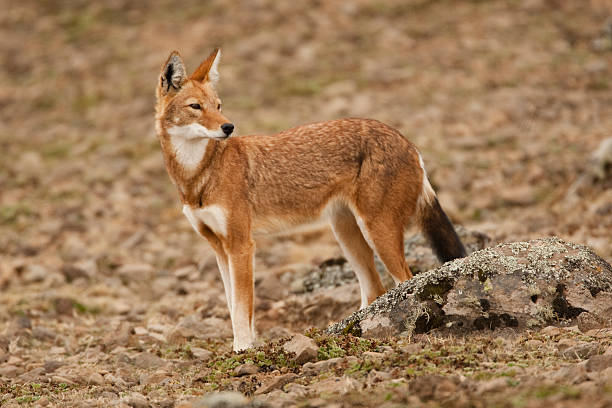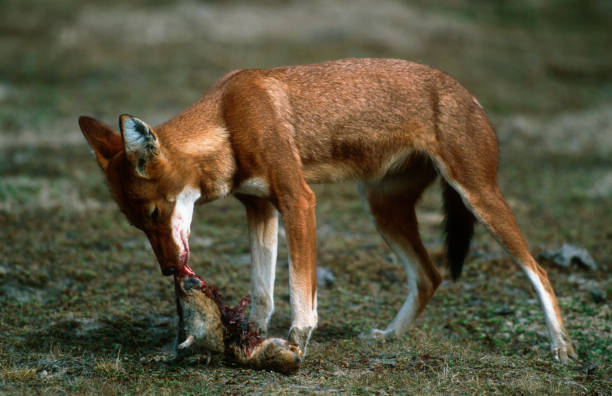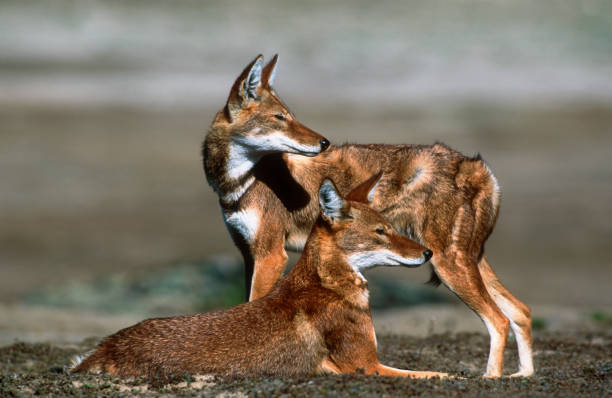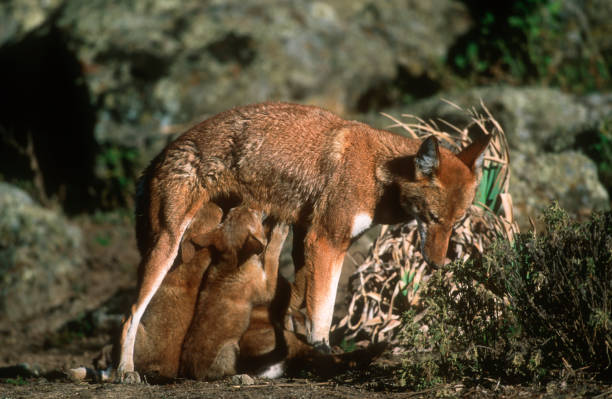Table of Contents
Scientific Classification
| Kingdom | Animalia |
| Phylum | Chordata |
| Class | Mammalia |
| Order | Carnivora |
| Family | Canidae |
| Genus | Canis |
| Species | C. simensis |
| Scientific Name | Canis simensis |
Description
The Ethiopian Wolf, also known as the Simien Jackal, is a truly rare and graceful canid that roams the highlands of Ethiopia. It holds the title of Africa’s most endangered carnivore and is recognized as the world’s rarest wolf species. With its slender build and long legs, it bears a resemblance to a coyote, but its striking reddish-orange coat sets it apart. You’ll notice its belly, throat, and muzzle are adorned with white markings, and its narrow snout along with upright ears give it a fox-like appearance. This agile creature is built for speed and stealth, making it a skilled predator.
Adult Ethiopian Wolves typically weigh between 25 to 42 pounds. While they are classified as wolves, they don’t go after large prey. Instead, they’ve honed their skills in hunting rodents, which plays a vital role in their ecosystem.

Distribution
Ethiopian Wolves live only in the Ethiopian Highlands. They are not found anywhere else on Earth. Their distribution is fragmented, with populations isolated by human settlement and agricultural expansion. The six known populations are primarily located in:
- Bale Mountains National Park (the largest population)
- Simien Mountains
- Menz-Guassa
- North and South Wollo
- Guna and Choke Mountains
Their range has greatly decreased in recent decades. This is due to habitat loss and disease.
Habitat
These wolves are right at home in the Afroalpine regions. They prefer the high plateaus and grasslands that sit above 3,000 meters (around 9,800 feet). This unique ecosystem is marked by sparse vegetation, rocky outcrops, and seasonal marshes. It’s a chilly, misty environment where fog and frost frequently blanket the ground. At night, temperatures can drop below freezing, making it a tough place for most creatures. Only specially adapted plants and animals can survive here.
Wolves have a particular fondness for areas teeming with giant mole-rats and grass rats, which are their primary food sources. Unfortunately, these habitats are under threat from grazing animals and farming activities, leading to increased fragmentation.
Diet
Ethiopian Wolves are fascinating carnivores with a pretty specific diet. They primarily feast on rodents, with a whopping 96% of their meals made up of small mammals. Some of their favorite prey includes:
– Big-headed African mole-rat (Tachyoryctes macrocephalus)
– Brush-furred rats
– Grass rats
– Occasionally, they might snack on small birds, young antelope, and even insects.
When it comes to hunting, these wolves prefer to go solo and are incredibly precise. With their keen sense of hearing and smell, they’re always on the lookout for any movement before they make their move. What sets the Ethiopian Wolf apart from other wolves is its slender build. While many wolves hunt in packs for larger prey, the Ethiopian Wolf is built for speed, allowing it to chase down and ambush those quick, burrowing critters.

Behavior
Ethiopian Wolves are fascinating creatures, especially when you consider their social behavior. Even though they’re social animals, they prefer to hunt solo. Their social structure stands out among canids, with packs typically consisting of 3 to 13 members, often led by a dominant breeding pair. Interestingly, these packs focus more on defending their territory together rather than hunting as a team.
Communication within the pack is quite unique, relying on scent marking and howling to keep in touch and safeguard their territory. You’ll often hear howling sessions at dawn and dusk, which not only help gather the pack but also serve to ward off any intruders.
While they are very territorial, they manage to coexist peacefully within their group, forming strong social bonds. They take the time to groom each other and share responsibilities, whether it’s defending their land or looking after the young ones.

Lifespan
Ethiopian Wolves typically have a lifespan of about 8 to 10 years in the wild. However, in more protected or quieter environments, some of them can live even longer. Unfortunately, their life expectancy can take a hit due to various threats, including diseases, car accidents, and conflicts with humans.
Juvenile mortality rates are particularly high, mainly because of predators and environmental challenges. This situation adds to the already fragile population of this species.
Reproduction and Lifecycle
In a wolf pack, it’s typically the alpha female who does the breeding. This strategy ensures that the pack can concentrate its resources on raising a smaller number of healthy pups. Mating takes place during the dry season, which runs from August to November, and the gestation period lasts around 60 to 63 days.
When the time comes, the female gives birth to a litter that can range from 2 to 6 pups, which are nurtured in dens that they dig into the ground. These dens are often reused for many years and are usually located in rocky crevices or under boulders for added protection.
Even though only the dominant pair breeds, the whole pack pitches in to help raise the pups. The subordinate wolves bring food to the mother, and later, they’ll regurgitate it for the little ones. The pups start to venture out of the den when they’re about three weeks old and are weaned by the time they reach 10 weeks.
As young wolves grow, they generally stay within their pack’s territory. However, as they mature, some may decide to leave and either join other packs or even start their own.
Predators
In the lofty realms where the Ethiopian Wolf roams, it has few natural enemies. Yet, the young pups are at risk from:
– Birds of prey
– Hyenas
– Jackals
The real dangers, however, come from humans and are often indirect. Domestic dogs can carry rabies and canine distemper, leading to significant declines in their population. Additionally, human activities like poaching, poisoning, and habitat destruction continue to put immense pressure on this remarkable species.
Adaptations
The Ethiopian Wolf has made key adaptations to thrive in cold, low-oxygen areas:
- Thick fur to insulate against cold temperatures
- Long legs that allow it to travel swiftly over uneven terrain
- Acute hearing and sight for spotting small prey
- Slender muzzle and jaw strength ideal for grabbing rodents from burrows
- Social cooperation for territorial defense in fragmented landscapes
These adaptations suit a specific ecological niche, so changes can easily affect them.
Nest
Ethiopian wolves have a unique way of raising their young—they don’t build nests like many other animals. Instead, they dig out dens in quiet, elevated spots. These dens can either be burrows created by mole-rats or ones that the wolves have excavated themselves.
The pack takes great care to keep these dens clean and secure. Often, the subordinate wolves act as sentinels, watching over the pups while they’re inside. These cozy dens offer warmth, safety, and a stable environment, which is crucial for the delicate early days of a pup’s life.
Mating Season
The mating season happens during the dry months, from August to November. This timing ensures that births occur with the wet season that follows. This makes sure nursing mothers and growing pups get enough food, especially rodents. They multiply quickly during this time.
This season, hormones trigger affection and courtship in the dominant pair. Meanwhile, subordinate wolves help protect the den area.
Breeding
Breeding in a pack is all about hierarchy, with only the alpha male and female taking on the responsibility. This setup helps to avoid overusing resources and ensures that each litter gets the attention it needs.
Once mating is successful, the female will either dig a new den or spruce up an old one. After the pups are born, they spend a few weeks nursing before transitioning to solid food that’s been regurgitated. Thanks to this cooperative breeding approach, even the subordinate females, who don’t breed, pitch in to help raise the pups.
This communal effort not only increases the pups’ chances of survival but also helps keep the peace within the pack.

Interesting Facts
- Did you know some fascinating facts about the Ethiopian Wolf? It turns out this unique creature is actually more closely related to the gray wolf and coyote than to the African jackals we often think of. Sadly, it’s also the most endangered canid on the planet, with fewer than 500 of them left in the wild.
- One of their favorite meals is the giant mole-rat, which makes up more than half of their diet in the Bale Mountains. Unlike most wolves that hunt in packs, Ethiopian Wolves prefer to go solo, stalking their rodent prey on their own.
- You might notice that their fur changes a bit with the seasons, becoming brighter during the dry months. Their highland home is sometimes called the “Roof of Africa,” which is quite fitting! Unfortunately, rabies outbreaks have been devastating in the past, wiping out as much as 75% of their population in just a few months.
Conservation Status
The Ethiopian Wolf is currently classified as “Endangered” on the IUCN Red List. With fewer than 500 mature individuals left, its population is on the decline due to several factors:
– Habitat loss caused by agricultural expansion
– Disease spread from domestic dogs, including rabies and canine distemper
– Fragmentation of populations, which leads to inbreeding and a decrease in genetic diversity
– Poaching and accidental poisoning

Fortunately, there are ongoing conservation initiatives like vaccination campaigns, habitat protection, and educational efforts. The Ethiopian Wolf Conservation Programme (EWCP) is at the forefront of these efforts, collaborating closely with local communities to safeguard this national treasure.


